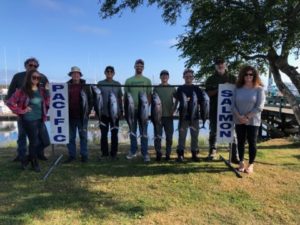Catching Shiny Silver Torpedoes
For the eighth year running, at 3:30 a.m. on the Sunday of Labor Day weekend, ten family members, homeys and one “close enough” found ourselves aboard the Katie Marie. We were about to be briefed on the rules, regulations, and expectations of our day’s tuna fishing adventure with Captain Loyal, his Co-captain Rich, and deckhands Nathan and Jeff. Our traditional captain, Captain Rob Gudgell., was on another assignment this year. For the first time in a couple years, the Pacific’s weather and water seemed fully inviting.
This whole tradition started in in February of 2012, when I connected with Milt Gudgell, owner of Ilwaco’s Pacific Salmon Charters, at the Central Washington Sportsman Show in Yakima. Once we started talking about his one-day tuna trips, especially aboard the ten-angler Katie Marie, I saw the possibilities for a family fishing and camping trip to Ilwaco. And so it has been.
While we have consistently made our Sunday of Labor Day weekend adventure chasing albacore tuna, each year has been unique. We filled the boat with 88 fish the first year, then had a couple fairly successful years before being scuttled by the weather on 2015. We bounced back in ’16 and ’17, with the big ocean so rough a year ago that we could not reach the tuna. Each year a slightly different mix of 10 ne’er do wells came aboard. Through time, an annual core of tuna nuts (me, last-of-the-Hucklings Edward, his kid brother Jonathan and my eventual son-in-law Brian) has been joined by various and sundry other family, homeys, friends and the occasional welcomed wait-lister.
Always, enough non-fishing family members came to make a memorable camping weekend. This year, however, the untimely death of son-in-law Brian and a couple broken wrists among our regular camping family members somehow discouraged several friends and relatives from wanting to hang out in camp and play on Long Beach while the rest of us chased albacore.
Thus, this year, the only campers were those of us heading out on the boat. Daughter Anna and son Edward found their way up from Los Angeles. Jonathan flew in from Denver, Cousins Dave and Debbie Yount wandered down from Tacoma, Kevin Clements drove down from Cumberland, Eric Anderson and son Gene arrived from Yakima and Vancouver. I came in from Ellensburg and we filled out the boat with JJ from Yakima.
Once Cap finished his cautionary tales, we left Ilwaco Harbor and headed into the Pacific. Some 30 miles out, Cap had the crew bait rods with streamers and toss them out behind the moving boat. A strike on one of those rods, and several folks would yell “Tuna! Tuna!” signaling all of us to hit the railing on the windward side of the boat and get ready to fish. The water had just enough wave and trough action to make a couple of our gang seasick, the wind and air temperature was comfortable, and the skies were off and on slight drizzle and clearing.
Generally, at those “Tuna!” moments, gulls and other seabirds would be circling “boiling water,” the result of large spherical schools of small fish (called “bait balls”) jumping to escape the tuna chasing them. Often we could see the shiny, silvery, tuna flashing by the boat just under the surface at speeds up to 50 miles an hour. To those who’ve seen torpedoes in the water, the similarities are striking, thus the nickname “silver torpedoes.”
Nathan or another crew member would quickly be at our rod station along the windward railing, get a live anchovy onto our hook, and tell us to get it in the water. Cap would allow the boat to drift across the school of tuna, as we fed line – thumb on the spool and drag disengaged – to the anchovy swimming away from the boat.
At some point, if everything worked properly, the anchovy would race away at 40 miles an hour. We would then count to ten aloud and slowly. At “ten,” the fisher would engage the drag and find him- or herself in a battle with a very stubborn tuna. Slowly, line would be gained, as the tuna moved around the boat. The angler would have to follow the fish, going over – or under – every other fisher in the way. If another angler had a fish on (pretty common) it was imperative to keep the lines separated with that over or under decision; two taut lines crossing generally meant two lost fish. This invariably would greatly irritate the captain and crew (not to mention the rod holders). It is great high adventure.
The bite might stop as quickly as it began. Cap would call all lines back aboard and head out to find another boil of baitfish and another school of tune. Then we would do it all again.
Amid all the catching and excitement will often be five- to six-foot sharks taking the baits and cutting lines, along with (on this trip) five seabirds which grabbed baits being reeled back to the boat. If the sharks start ruling a drift, Cap will head out for a new tuna school. The seabirds, irritated as they were at being dragged aboard, were all released.
This “Tuna! Head to the rail!” process repeats until the day is far enough along that we must head back to port, or the crew announces that there is no more room on the boat for more fish.
By late afternoon, as the Katie Marie turned toward port, the ice bins held 63 tuna from 14 to 35 pounds. With aching arms and big smiles, we turned to plans for canning, smoking and freezing the filets to come.
Somewhere in there were discussions about “next Labor Day Weekend.”







